Maybe a name or that of a football team carved by some visitor into a tree trunk or scratched onto a stone. It is of little meaning or matter to anyone other than the scribe – indeed it might even cause offence. I, a stranger, was here and wanted to leave my mark. Some may say an act of defacement – vandalism.
Then again there may be occasion that one looks upon such marks with interest. Etchings made on walls and timbers by those held captive for example, perhaps hundreds of years ago. They communicate something of event and history which might otherwise be unrecorded, connecting with period and perhaps eliciting thoughts of deprivation, hardship and the like.
Chepstow Castle, the oldest post Roman stone fortification in Britain. One cannot help but admire the beautiful details in amongst the scale and grandness of it all. The oldest surviving castle doors in Europe hung in 1190, the forge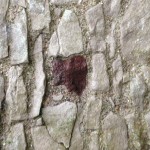 d iron pins, carved arrow ports, bleached oak and so on. But then something for which no explanation can be given. A single cricket ball sized red stone set amongst the mass of light coloured rock in this monumental fortified structure – well above eye level and still secure in its original unblemished gritty course. Perhaps a piece of the old red stone one finds near St Davids or red Jasper from the North of Wales. Closer inspection with a ladder might tell. The point is that it can only have been placed there deliberately and for some reason. A signature of one of the stonemasons perhaps, maybe a levelling or alignment mark. The guides on duty did not know nor had they noticed it before. But it made everybody think – and imagine. It HAS to mean something!
d iron pins, carved arrow ports, bleached oak and so on. But then something for which no explanation can be given. A single cricket ball sized red stone set amongst the mass of light coloured rock in this monumental fortified structure – well above eye level and still secure in its original unblemished gritty course. Perhaps a piece of the old red stone one finds near St Davids or red Jasper from the North of Wales. Closer inspection with a ladder might tell. The point is that it can only have been placed there deliberately and for some reason. A signature of one of the stonemasons perhaps, maybe a levelling or alignment mark. The guides on duty did not know nor had they noticed it before. But it made everybody think – and imagine. It HAS to mean something!
One soon becomes accustomed to the dry white limestone walls bordering the road on Ratlin Island. They are unusual, probably unique to  the place, and in admiring their contribution to the island environment one wouldn’t necessarily enquire as to their history. After all – they are only walls. But then a date. 1833 – marked in the wall using black basalt from the adjoining beach. The imaginative of someone, a tenant farmer or labourer, to record not himself but the year of construction.
the place, and in admiring their contribution to the island environment one wouldn’t necessarily enquire as to their history. After all – they are only walls. But then a date. 1833 – marked in the wall using black basalt from the adjoining beach. The imaginative of someone, a tenant farmer or labourer, to record not himself but the year of construction.
In the small city of Trier in the Mosel Valley – a mark etched in the stone of the large entrance gate known as the Port a Negro built nearly two thousand years ago. Low down within the stone portal of the gate a signature of the builder to acknowledge payment for his work. The whole magnificent structure a story of the grand history of empire – that one small mark bringing to the story one unknown individual, his instruction, maybe his hand and a day to day event.
a Negro built nearly two thousand years ago. Low down within the stone portal of the gate a signature of the builder to acknowledge payment for his work. The whole magnificent structure a story of the grand history of empire – that one small mark bringing to the story one unknown individual, his instruction, maybe his hand and a day to day event.
I’m sure you could think of many such marks you have seen. What do you make of these? One connects with the banner picture on our home page the another a piece of Norfolk brick built into a dry stone wall in Ireland.
On reflection and when visiting somewhere for the first time with what I feel to be an open mind I often find myself leaving with a sense of having been taken by something – yes – unexpected! Open mind huh!
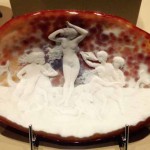
This was the case during a recent visit to the gem museum in Idar-Oberstein near Frankfurt. I’ll maybe chat a little about Idar in a later post, suffice to say it is home to this gem museum and appropriately so given its historic status since the 15th Century as a centre for mining agate and, many would argue, the global epicentre for fine semiprecious stone carving.
A picture may cost a couple a euro for the museum permit but it often conveys more than a thousand  words and by showing a handful I hope you will get a feeling for the exceptional levels of skill and creative vision upon which, over the generations, the name of the ‘River Idar’ has become synonymous.
words and by showing a handful I hope you will get a feeling for the exceptional levels of skill and creative vision upon which, over the generations, the name of the ‘River Idar’ has become synonymous.
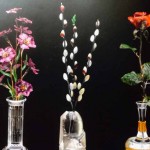
Among all the beautiful works there was in one room a row of cabinets displaying worked and ‘rough’ specimens of emerald, ruby, sapphire, beryl, lapis lazuli, turquoise and many others types of precious and semi-precious stones – all marked ‘Synth’. Rather un-inspiringly displayed I passed on, returning to it having completed my ‘tour’ with a slightly troubled feeling of having missed something. I couldn’t dally as it was past closing time but I did take a couple of quick pictures. ‘Ja, Ja, of course’ explained the very kindly attendant in her limited English as she shepherded me out, ‘it is material made in a factory, synthetik’.
‘Ja, Ja, of course’ explained the very kindly attendant in her limited English as she shepherded me out, ‘it is material made in a factory, synthetik’.
I am sure most of you are more worldly wise than I but I suspect there may be some who like me were unaware as to the extent of industry’s capability to manufacture precious stones – sapphires, emeralds, ruby’s, diamonds – all flawless and created to any desired colour or shade, not to mention a range of the more prized semi-precious stones. A sort of modern day alchemy – all being used for jewellery manufacture and, in the case of diamonds for industrial applications as well. Desirable to makers of jewellery because they are cheaper – and consistent in, dare I say it, quality.
the more prized semi-precious stones. A sort of modern day alchemy – all being used for jewellery manufacture and, in the case of diamonds for industrial applications as well. Desirable to makers of jewellery because they are cheaper – and consistent in, dare I say it, quality.
I have to confess I was rather shocked, perhaps naively. The romantic notion of a piece of material that has been sheltered for millions of years, unearthed and shaped by the hand of man into something beautiful – shattered! And the fact that it is flawless – manufactured perfection – the perfect 10, the

unblemished complexion on a photo-shopped face….. Is it a fraud or is it not? However strong the connection will someone in years to come be disappointed when they are told that their magnificent sapphire is synthetic? It can be detected using sophisticated spectroscopy techniques.
In some way it seems different to the production of pearls in culture – the cheapest a mere few microns of pearl on a plastic bead. Is that what it will come to – the laying down or fusion of a layer of material onto a cheap base of the same refractive index? Who knows – this may be the future of mass production jewellery.
Sitting on my workshop table when I returned home, alongside a Lapis dome I’d fashioned during training, was a pair of ‘practice’ cufflinks I’d also made using a small piece of rough Lapis Lazuli. Revealed only when it was cut were irregular inclusions of calcite and a scattering of golden pyrite flecks in such a pattern as to give it an almost celestial appearance – like a tiny picture a child might imagine taken in the depths of space.  I looked at my dome and the Lapis in the cufflinks against the photograph of the even coloured and flawless synthetic materials I had seen in the museum and thought, this is nature, this is uniqueness, these pieces have an identity. Celebrate the difference and hats off to natures wonderful, surprising, beautiful, at times exasperating for the designer – but perfect ……. IMPERFECTION!! Or should that be Imperfect Perfection
I looked at my dome and the Lapis in the cufflinks against the photograph of the even coloured and flawless synthetic materials I had seen in the museum and thought, this is nature, this is uniqueness, these pieces have an identity. Celebrate the difference and hats off to natures wonderful, surprising, beautiful, at times exasperating for the designer – but perfect ……. IMPERFECTION!! Or should that be Imperfect Perfection


It’s been quite a while since my last post – in truth because I have found this one surprisingly difficult to write. Reminiscing can sometimes stir up all manner of things – a challenge to one unaccustomed to writing!
I was fortunate to have been raised in the North Wiltshire countryside – a land of open rolling downland, ridgeways, escarpments, fertile vales, forests and  chalk streams – a far cry from the more intimate ‘basket of eggs’ drumlin country in which I now live. Farming during breaks from school and university one saw the seasons come and go, the early morning sunrise and the day’s end, the ever changing landscape crafted like some giant abstract by maturing crops and the plough. It was at times arresting in its beauty.
chalk streams – a far cry from the more intimate ‘basket of eggs’ drumlin country in which I now live. Farming during breaks from school and university one saw the seasons come and go, the early morning sunrise and the day’s end, the ever changing landscape crafted like some giant abstract by maturing crops and the plough. It was at times arresting in its beauty.


The area was dotted with ancient and prehistoric sites – Neolithic settlements and flint mines, stone circles, long barrows, iron age forts, white horses – tumuli everywhere and even a Roman mint. Avebury, Martinsell, West Kennet Long Barrow, Silbury Hill, Overton Down and further away Stonehenge, a 2 hour bike ride.
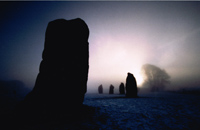
Exploring was a staple pastime of youth for we saw ourselves as latterday hunter gatherers – searching for flint artifacts, roman coins, fossils or unusually coloured stones; carving things from bits of wood. Observing the colouration of flint in firebeds on bronze and iron age sites, oranges through reds. All fuel to the fire of our collective youthful imaginations. Man and stone – connected. And wood of course – happy days. So it might not come as a surprise that I felt an immensely deep sense of belonging when I returned after many years of absence. The thrill of rediscovering sensations – the warm, earthy scent of summer rain on sun  baked chalky soil, the smell of the local ale. The re-awakening of that youthful imagination and curiosity albeit tempered with broader knowledge, a greater sense of context and a few miles on the clock. And an even greater interest in stone.
baked chalky soil, the smell of the local ale. The re-awakening of that youthful imagination and curiosity albeit tempered with broader knowledge, a greater sense of context and a few miles on the clock. And an even greater interest in stone.

Flint nodules as if from the hand of Moore himself, the beauty of its hidden colour made all the greater for the difficulty in finding unblemished material. The realisation that in prehistoric times a simple adornment painstakingly made was a true measure of reverence or love.
Given a long held interest in the visual and creative arts it was perhaps unsurprising that this rekindled interest in stone would be as warm water on the little seed I mentioned in the last blog. I became determined to make something – and it had to be from flint, the stone of our 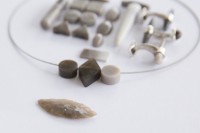 primitive forefathers. Perhaps a contemporary take on an ancient tool – in one of a million shades of grey.
primitive forefathers. Perhaps a contemporary take on an ancient tool – in one of a million shades of grey.
Determined to learn the skills and do it with my own hands the next stage of the journey began and over the following couple of years working with pieces of rough stone from all over the world the realisation soon dawned on me that the true beauty of nature was in it’s wonderful imperfection. Maybe some more about that next time.